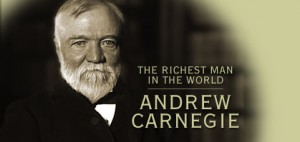Andrew Carnegie
Andrew Carnegie’s life embodied the American dream: the immigrant who went from rags to riches, the self-made man who became a captain of industry, the king of steel.
Carnegie was born in Dunfermline, the capital of Scotland, on November 25th, 1835. Andrew was the second of two sons of Will, a handloom weaver, and Margaret, who did sewing work for local shoemakers. In 1848, the Carnegie family moved to America in search of better economic opportunities and settled in Allegheny City , Pennsylvania. Andrew Carnegie soon started working as a bobbin boy at a cotton factory, earning $1.20 a week.
Andrew was a very hardworking person and he had a series of jobs before making his fortune, including messenger in a telegraph office, secretary, and telegraph operator for the superintendent of the Pittsburgh division of the Pennsylvania Railroad. In 1859, Carnegie succeeded his boss as railroad division superintendent. He then made profitable investments in a variety of businesses, including coal, iron and oil companies and a manufacturer of railroad sleeping cars. By the age of thirty, he was very wealthy.
After the Civil War, Andrew saw the potential of Iron and resigned from the Pennsylvania Railroad. He set his course on the Keystone Bridge Company, which worked to replace wooden bridges with stronger iron ones. In three years he had an annual income of $50,000.
The Steel Business
In 1865, Carnegie combined three of his companies into the Carnegie Steel Company with his partner, Henry Clay Frick, a wealthy industrialist who controlled the coke industry in the Pittsburgh area(Coke is a fuel made from coal). He was possessed by technology and efficiency in a way no businessman before him had ever been, this resulted in lower costs and underselling the competition. Andrew had made his steel mills the most modern in the world, and the models for the entire industry. By 1900, Carnegie’s mills steel was cheap and produced more metal than all of Great Britain and his company was the largest steel company in the world. Suddenly bridges and skyscrapers were not only feasible but affordable, too. Steel fed national growth, provided more jobs, national prestige, and a higher quality of life for many.
While Carnegie had built a reputation as being a pro-labor industrialist, Frick was harsh with the steelworkers and did everything he could to control them and break their labor union. He cut their pay and ruthlessly put down strikes by the steelworkers. While Carnegie was away from the business, union workers protested wage cuts, Frick locked out the striking steelworkers at the mill in Homestead, Pennsylvania, and hired Pinkerton guards to keep them out. Fighting broke out between the strikers and the guards, and 10 people were killed, including seven steelworkers. This has been known as the Homestead Strike of 1892. Frick left the company when Carnegie didn’t agree with the way Frick handled the striking workers and the Homestead Strike ruined Carnegie’s reputation.
In 1901, banker John P. Morgan purchased Carnegie Steel for $480 million, making Andrew Carnegie one of the world’s richest men. Morgan then merged Carnegie Steel with a group of other steel businesses to form U.S. Steel, the world’s first billion-dollar corporation
After Steel
Carnegie turned his attention to giving away his fortune before he died. He spent much of his collected fortune on establishing over 2,500 public libraries, dedicated to research in science, education, world peace, as well as supporting institutions of higher learning. By the time Carnegie’s life was over, he had gave away 350 million dollars. Carnegie died at age 83 on August 11, 1919, at Shadowbrook, Massachusetts .
References
“Andrew Carnegie .” “Steel Business” PBS. n. page. Web. 7 Dec. 2013. <http://www.pbs.org/wgbh/amex/carnegie/peopleevents/pande01.html>.
“Andrew Carnegie .” History. n. page. Web. 7 Dec. 2013. <http://www.history.com/topics/andrew-carnegie
“Steel Business” PBS. n. page. Web. 7 Dec. 2013. <http://www.pbs.org/wgbh/amex/carnegie/sfeature/mf_flames.html>.
“This Week in History: The American industrialist Andrew Carnegie was born in 1835.” World Book Blog. (2013): n. page. Print. <http://blog.worldbook.com/2013/11/25/this-week-in-history-the-american-industrialist-andrew-carnegie-was-born-in-1835/>.

 Download this page in PDF format
Download this page in PDF format